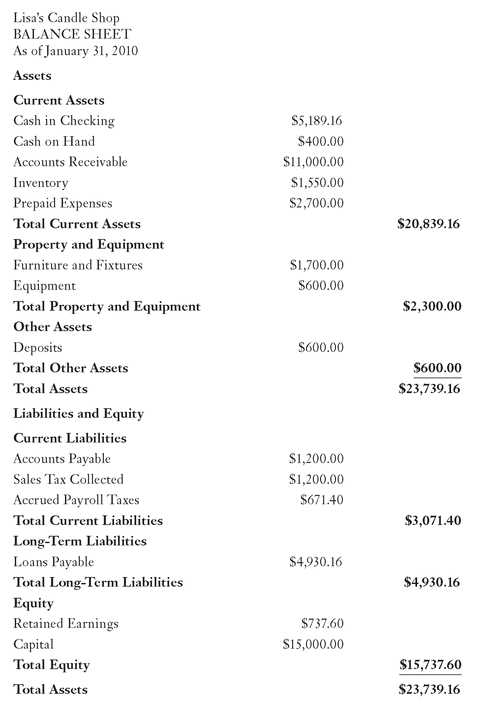Producing the Balance Sheet
,The first step is to develop the balance sheet. The balance sheet is a quick glance at your business at some point in the year. This financial statement is always done on a year-to-date basis until you get to the year-end close.
We develop the balance sheet for Lisa’s Candle Shop and then show you various financial analysis tools that help gauge how the business is doing. These tools are useful to management for internal assessment as well as to external entities, such as a bank or potential investor.
Here’s the balance sheet for Lisa’s Candle Shop at the end of February.

Before we start analyzing the numbers, let’s take a quick look at the format. You’ll notice that we’ve grouped the accounts in several categories. For Assets, we have Current Assets, Property and Equipment, and Other Assets. For Liabilities and Equity, we have Current Liabilities, Long-Term Liabilities, and Equity.

DEFINITION
Current Assets includes the total of accounts a business has in cash and cash equivalents, Accounts Receivable, Inventory, Marketable Securities, Prepaid Expenses, and any other assets that can be converted to cash in less than one year. Current Liabilities is the total of all money owed by a company that is due in less than one year.
These groupings make it easier for you and any financial institution or investor to quickly see the status of your company. The Current Assets section includes assets that will be used in a 12-month period. The same time frame is true for Current Liabilities, which includes liabilities you’ll need to pay within 12 months.
Anything that has an impact on your assets or liabilities for more than 12 months fits into a long-term category. On the asset side you may have additional categories such as Land and Buildings and Intangible Assets, which could include line items such as Patents, Trademarks, and Copyrights.
The Equity section for most businesses that are not sole proprietorships will also have an account in the Equity section of the balance sheet for common stock. That would normally be the first account in the Equity section if Common Stock has been issued.

ACCOUNTING ANSWERS
If you want to learn more about financial statements and how they are interpreted, IBM did an excellent job of explaining them at this website: www.ibmcom/investor/help/guide/introduction.wss.
When we start analyzing the following balance sheet you will see why these categories become very useful for various analytical tools. Before we can show those tools, we also need to prepare a balance sheet for the month of January, so we have something we can use for comparison to evaluate the health of the business. Here’s the balance sheet as of January 31, 2010.

Now let’s see how these two balance sheets can help you assess your cash status, manage your assets, and review your debt. All this is done with ratio analysis, which shows you the relationships between financial statement accounts.
To help you understand how well your business is doing, you need to compare it to others in the same industry. You can do that by finding out the industry averages for your business. We checked Bizstats.com to find out the industry averages for Lisa’s Candle Shop. There are a number of categories for retail. We’ll use the ones for miscellaneous retail stores to learn how to use these ratios.
..................Content has been hidden....................
You can't read the all page of ebook, please click here login for view all page.

